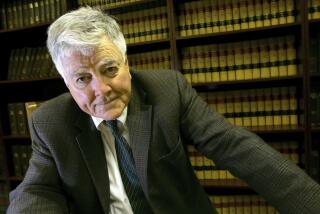For Politician Who Concocted a Tale of Heroism, the End Began on TV
- Share via
SALT LAKE CITY — Look closely at the 40-year-old tape of U.S. Rep. Douglas Stringfellow’s appearance on the TV program “This Is Your Life,” and you will see the look of a trapped animal in his eyes.
Watch as his exploits as an OSS spy in World War II are extolled, as his friends and family are introduced by the ever-smiling host, Ralph Edwards.
“At that moment I would have bartered my life to have prevented the telecast,” Stringfellow later wrote. “Outwardly calm, I was shaken to my very depths within. Somehow I sensed this was the beginning of the end.”
It was. Nine months later, in October, 1954, his war record was exposed as a hoax and his promising political career ended in disgrace.
But at that moment, on national television, Stringfellow considered giving up the charade he had lived since war’s end. He just couldn’t do it.
“I had to get out the best way that I could--without splashing all over my family and friends,” he wrote.
How had one of the brightest young stars in the Republican firmament managed to turn his life into a lie, one he couldn’t even share with the wife and soul mate he called “Funny Face”?
His never-published autobiography, obtained from family members who remember him with love, offers some clues.
Stringfellow was shipped home to Utah from France in January, 1945. A lowly infantryman, overseas barely two weeks, he had been part of a mine-clearing detail when shrapnel from an explosion slammed into the base of his spine.
Bedridden with lifeless legs, utterly depressed by his meaningless role in the toppling of Nazi Germany, Stringfellow sought solace in flights of fancy.
“Without a past to recall, a future to plan and build for, I fled each night to that world of fantasy where time and space did not exist. I roamed the battlefields of the world, conquering the enemy and restoring peace to a war-torn Earth. Thus, psychologists do not think it so strange that I awoke one morning consciously remembering my dramatic but imaginary part in a war that was all too real.”
Word of Stringfellow’s imagined exploits spread among fellow veterans, friends and family in his first days at Bushnell General Hospital in Brigham City. The tales already were common currency when Shirley Mae Lemmon, known to friends as Lee, danced for the Bushnell convalescents on Stringfellow’s 23rd birthday. They were married 10 months later in the Mormon Church’s Salt Lake Temple.
A naturally gifted public speaker, Stringfellow, standing with canes and leg braces, held audiences in thrall with his detailed accounts of wartime derring-do. A 1946 stint as state chairman for the Young Republicans opened a shining path to politics even as he embarked on a promising career in radio.
In 1950, the Freedom Foundation picked Stringfellow third, behind Gen. Dwight D. Eisenhower and former President Herbert Hoover, for noteworthy public speaking. Two years later, voters in Utah’s 1st Congressional District sent him to Congress in a Republican landslide.
Although just 30, demand for his spellbinding speeches brought him 200 engagements a year.
Finally, in the summer of 1953, Stringfellow admitted to himself he must have imagined his heroism: He had not parachuted into Germany on a secret mission, had not kidnaped German nuclear physicist Otto Haun, and had not been caught and tortured by the Gestapo at the Belsen concentration camp before escaping to tell the story.
On Oct. 14, 1954, the Army Times broke the story that Stringfellow had made it all up. Lee Stringfellow learned the truth only hours before it was front-page headlines.
“Nobody ever gave me an inkling,” she recalls. “I was in such a state of shock. But my main concern was for Douglas.”
Two days later, under intense pressure from Mormon Church and Republican leaders, Stringfellow made a tearful television appearance, admitting the hoax and offering to abandon a reelection campaign everyone had expected him to win.
Party leaders agreed, and his political career was over.
“I’d come home and he’d be sitting there with tears in his eyes listening to ‘Madame Butterfly,’ ” said his widow, now 67 and a retired psychologist. “That was when he was writing his book.”
Virtually unemployable in Utah, Stringfellow stayed home while his wife worked and went back to school. To protect her husband and four children from hostility in his home state, she coaxed him to Mexico, where his paintings sold briskly and he knew some peace.
He died of a heart attack in 1966 at age 43, leaving a 385-page autobiography he tied up with string and put away in a drawer. In it, he described his “This Is Your Life” ordeal and something else that happened later that day.
At a Los Angeles hotel, his father, a retired Utah sheepman, handed him a sealed envelope and told him not to read it until after boarding a plane to Cleveland.
It read, in part:
“You have been acclaimed by the multitudes for your part as a war hero. In our pride in the moment, our desire to please, we sometimes exaggerate and embellish the facts.
“You are no longer a child seeking praise. . . . Put that part of your life behind you before it destroys you. I think you will understand what I mean. I implore you, my son, to forget it. My prayers go with you.”
More to Read
Get the L.A. Times Politics newsletter
Deeply reported insights into legislation, politics and policy from Sacramento, Washington and beyond. In your inbox twice per week.
You may occasionally receive promotional content from the Los Angeles Times.









